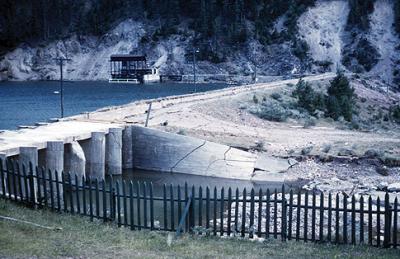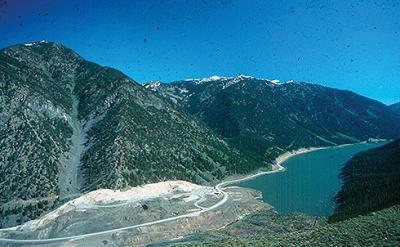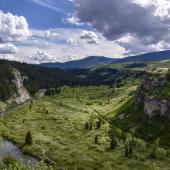Yellowstone Earthquake at the Madison River
The Madison River, flowing near Yellowstone National Park in southwestern Montana, normally appears peaceful and inviting. It has been a popular destination for millions of vacationers during the last 60 years.
But just before midnight on August 17, 1959, this terrain was violently shaken. An earthquake originating 20 miles below ground shook with tremendous energy, measuring 7.5 on the Richter scale. At the time it was the fourth strongest quake ever recorded in the United States.

Two massive pieces of land dropped 20 feet or more. Three giant scarps appeared; these are sheared faces of land that are the mark of an earthquake.
Within seconds, the earthquake dealt its most damaging blow. High above the Madison River on the steep canyon wall, weathered layers of gneiss and schist that had been held up by a tremendous dolomite buttress began to slide. The dolomite buttress failed to hold
A three-quarter mile-wide swath of rock slid en masse down the mountainside into the narrow confines of the Madison River Canyon, displacing water in every direction. Rock completely filled the river channel and instantly dammed the river. Without any warning, a new lake, Earthquake Lake, began forming as the river backed up behind the slide.
Upstream from this great disaster, another nearly occurred. Hebgen Lake, created in 1915 when the Hebgen dam was built, was sloshing wildly over its banks. Huge waves, called seiches, overtopped the dam, washing into the river downstream.

The first reports of the earthquake included the dreadful news that the Hebgen Lake dam had failed. Fortunately, these reports were wrong. Nevertheless, the earthquake left its mark on the landscape forever.
The Hebgen Lake earthquake struck on a gorgeous moonlit night, rumbling across one of the nation’s most popular recreation areas. That night, at least 18,000 visitors were in Yellowstone. Around the region, campgrounds and local motels were filled to capacity. Even the roadsides were taken up with cars and trailers.
The quake rocked the land so forcefully that travelers awoke to sheer terror. Along Hebgen Lake, shoreline cabins, lodges, and travel trailers were inundated with water.
“ I went to sleep about 9:30 p.m. and was awakened by the frenzied jiggling of the trailer....When I got outside, the trailer was in place, but the trees were whipping back and forth and the leaves were rustling as if moved by a strong wind—but there was no wind. I knew right then that it was an earthquake. I heard avalanches in the canyons behind me and could see huge clouds of dust billow out of the canyon mouths.” — Irving J. Witkind, geologist with the U.S. Geological Survey, who happened to be on-site, conducting studies.
As Earthquake Lake quickly began to fill, frightened campers fled for their lives. But their only escape route, Highway 287, had cracked into pieces. While the ground shuddered with aftershocks, about 250 campers were forced to climb in the darkness, away from the rising water.
Those who were able to flee were the lucky ones. Twenty-eight never made it out alive. Nineteen bodies were never found and probably still lie somewhere near the buried Rock Creek Campground. Five people drowned west of the slide, two people died in the hospital in Bozeman, and a boulder at Cliff Lake Campground buried two.
What forces created this madness? How is it that this tranquil, majestic landscape was thrown into chaos? How soon may it happen again?
Though no one predicted the Hebgen Lake earthquake, geologists have known for years that temblors (earthquakes) frequent this region. What they cannot agree on is why.
Most earthquakes occur along the edges of continents, seismic belts where portions of the Earth’s crust are alternately sinking and rising, causing collisions between the Earth’s enormous tectonic plates.
But the Yellowstone area is different than other Montana parks. Here, earthquakes occur more than 1,000 miles from the continent’s edge.
A huge reservoir of molten rock heats the continent from below. Some scientists think that millions of years ago, a crashing meteor left behind enough heat to continue to warm the continental plate today. The latent heat, they say, brings on the Yellowstone region earthquakes.
Other scientists discount the meteor theory, saying that the Yellowstone area earthquake belt exists because the continental plate is stretching as hot rocks are thrust upward from below. They believe this process is responsible for the frequent earthquakes.
Whatever the cause, earthquakes occur here 8-1,000 times each year.
The Madison Range in general—and the Hebgen Lake area in particular—has all the factors necessary for regular earthquakes. The region is laced with faults, breaks in folded layered rocks where movement occurs.
Layered rock that accumulated over millions of years has been uplifted and folded. Along the folds thrust faults developed where the rock layers have broken. In between the faults are portions of earth called fault blocks.
The faults involved in the Hebgen Lake earthquake are the Hebgen Fault, the Red Canyon Fault, and the Madison Range Fault. The corresponding blocks are the 125-square-mile Hebgen Lake Block, the red Canyon Block, and the Missouri Flats Block.
When the earthquake occurred, all three blocks sank within seconds of one another. Both the Red Canyon Block and the Hebgen Lake block tipped toward their northern boundaries along the fault lines.
While the dropping of the Red Canyon block caused only minor damage, the Hebgen Lake block’s subsidence wrought real destruction, primarily because of the subsequent racing of the water in the lake. The north end of the lake dipped up to 19 feet.
The epicenter, the point directly above where the quake occurred, was located near Duck Creek and the junction of Highways 287 and 191, eight miles north of West Yellowstone, Montana. But the quake was powerful enough to be felt in eight states, across 500,000 square miles.
At Butte, about 100 miles northwest of Hebgen Lake, the motion reminded one reporter of “negotiating a rough patch of water in a small boat.”
As with most natural disasters, the hours following the earthquake were marked by chaos. Hundreds of people were trapped by the Madison River slide and damaged roads. Local, state, and federal authorities weren’t able to effectively organize until daylight, some five hours after the quake hit.

Mrs. Grace Miller, a 70-year-old widow and owner of the Hilgard Fishing Lodge on Hebgen Lake, awoke when the quake began. She ran out of her lodge door and jumped across a five-foot crevice just as her lodge dropped behind her into the lake. All of the buildings of the resort were destroyed by the quake.
A man trying to escape drove his family off a six-foot scarp along the red Canyon fault, overturning the car. Unbelievably, no one was seriously hurt.
Purley Bennett, his wife, and four children, were camped at the western edge of the canyon. The Bennetts were in their trailer and the children on the ground nearby. Awakened when the trailer started to shake, Purley Bennett left the trailer. Mrs. Bennett went out too, only to see her husband grab a tree, then disappear. Three of their four children were also gone.
A California couple perished when a huge boulder crashed through the Cliff Lake Campground, crushing them as they slept in their tent. Their three children, sleeping in a tent nearby, were unharmed.
At dawn, the U.S. Air Force sent four helicopters to do search and rescue. The Forest Service dropped in smoke jumpers who immediately began rescue operations. In all, 40 relief agencies were at work. By the close of the next day, 250 people had been rescued.
The trail left by the earthquake was devastating. In the first 24 hours, the amount of water in the Madison River nearly doubled. Within a month, the river was carrying three times more water than before the quake.
At final tally, $11 million in damage to buildings and roads had occurred. The sinking of the north shore of the lake left docks, beaches, and cabins under water. But on the south shore, 1,300 acres of muddy lakebed emerged.
It was Earthquake Lake, however, that presented the greatest challenge. With the victims rescued, the Army Corps of Engineers began a race against time. Water rising behind the slide threatened to destroy the Hebgen Lake Dam, or worse, overtop the slide and flood downstream. Teams worked around the clock, building a spillway for the water.

When water finally flowed through the spillway on September10, however, something was clearly amiss. The grade was too steep, and the rushing water quickly caused erosion. Work began anew, and on October 17, the new spillway at last carried the water from Earthquake Lake safely downstream, leaving the lake itself about 120 feet deep.
The bulk of the area hit by the quake is federal land administered by the U.S. Forest Service. A year later, the Forest Service created the 38,000-acre Madison River Canyon Earthquake Area. The visitor center marks the site of the Madison River Slide. It lies on the border of the Gallatin and Beaverhead National Forests on the western edge of the Greater Yellowstone Region.
More than 75,000 people visit the earthquake area each year. The visitor center and surrounding land provide travelers with a perspective on how land and lives can abruptly change when the forces of nature take over.
The Memorial Boulder, a remnant of the dolomite buttress, is marked with a bronze plaque holding each of the 28 victims names. Their stories remain etched in time forever.
The Hebgen Lake earthquake was not the region’s first. Temblors have rocked this land repeatedly over millions of years, but no major earthquakes had occurred in recent time until the Hebgen Lake earthquake occurred. That night, no one knew the earthquake was coming.
More than 40 years later, remnants of the massive Hebgen Lake Earthquake are readily apparent to the trained eye, the fault scarps, the changed river valley, the slide itself.
But the land is also healing. New trees are growing where old ones had been toppled. And the land has taken on a weathered look, as if it is steady, immovable.
Yet one day, surely, the fault blocks will sink again. And no one knows what the Hebgen Lake earthquake of the future will yield.
~ Lilly Tuholske is affiliated with the USDA Forest Service.












- Reply
Permalink